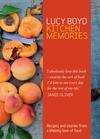Czytaj książkę: «Kitchen Memories»

TO DAISY,
ALEXANDRA AND MIA.
COVER
TITLE PAGE
DEDICATION
INTRODUCTION
SPRING
SUMMER
AUTUMN
WINTER
COOK’S NOTES
SUPPLIERS
LIST OF RECIPES
ACKNOWLEDGEMENTS
PICTURE SECTION
COPYRIGHT
ABOUT THE PUBLISHERS
INTRODUCTION
Taste has a memory – my first oyster sitting on a plush, wine-red bar stool in Wheelers restaurant on Old Compton Street in Soho; my brothers, sister and I all lined up along the bar and instructed to plop the silver quivering muscles into our young mouths by my mother. ‘Did you bite or swallow it whole?’ I can’t remember but I know the Tabasco helped, along with a squeeze of lemon juice, the lemon wrapped carefully in muslin to prevent the bitter seeds from affecting the flavour. I still prefer to eat oysters at a bar rather than at a table – I like the informality, even though at Wheelers the presentation was formal: monogrammed linen napkins and silver cutlery; the barman dressed in black tie; a vast, chilled silver bowl full of double cream to ladle into your coffee at the end of the meal. I am sure my passion for chilli and for double cream came from this early memory.
This book is inspired by memories, by cooking with my mother and by a love of simple fresh ingredients. Writing these recipes, Rose’s influence has been in every one and perhaps I have mentioned her too much, but then she taught me how to cook and that cooking is part of family life – a pleasure, not a chore, a way of living. The recipes themselves are either meals that I make on a regular basis for family or friends or a combination of my favourite ingredients as they come into season. There are few sauces in the book; instead of a Béarnaise I will use a squeeze of lemon or a glug of extra-virgin olive oil or perhaps a little chilli to finish off a dish. I love using anchovies and herbs to season: a piece of feta broken apart with a fork on a plate with a few slices of fresh chilli, a scattering of marjoram leaves and a slug of good olive oil is a vibrant alternative to marmalade on toast for breakfast. Rose gave me, my sister and brothers a sense that cooking needn’t be complicated and could be fun and deeply rewarding.
My brother, Ossie, recently called to tell me how he had cooked a wonderful meal on the far shore of the Falmouth Estuary in Cornwall with his friend Ab Rogers. They had picked up some live lobsters which they split in half and roasted over a hot stone fire they had made on the beach. My brother had brought with him a bottle of new season’s olive oil, a lemon, salt and pepper, one egg and a jam jar. He described how he cracked the yolk into the jam jar and made a fiery mayonnaise by adding the olive oil and lemon juice drip by drip, stirring with a spoon. I was impressed by his confidence in only bringing the one egg as I would have worried that the mayonnaise might split. He seemed unconcerned, only thrilled to have made something so simple and good. I took great vicarious pleasure in Ossie’s story as it was as much about the beach and the lobster, the sea and the hot stones as the memory of our mother and her influence on my brother that he had the nerve to bring just the one egg.
Even as children, and before Rose became professionally involved with cooking, she would get excited about food. The first morello cherries of spring would be de-stoned by us sitting around the table before being thrown into a large pan with sugar and boiled to a sweet and tart dark purple jam to spoon onto her crêpes with generous dollops of crème fraîche. There were no short cuts – no bought jams from the supermarkets – the making and the preparation of a meal was something that everyone would be involved in. An intuitive understanding and respect for ingredients as well as a curiosity about their potential made everything she cooked come alive. It was this approach to food that was exciting, as well as her gift for sharing with family, friends and later on at the River Café with not only the chefs but also the waiters, getting them involved with the prepping of the ingredients. It was the participation in the making of a meal that helped to give the restaurant an air of buzz and excitement.
Rose: inventive, creative and always taking advantage of where she was in order to break from her old life into a new unfolding interest. This ethos was in the front seat of the car every day when she picked us up from school and asked, ‘What would you like for supper?’ Not sausages, not spaghetti Bolognese (this was back in the 70s), it had to be more interesting than that – perhaps macaroni cheese with thin slices of blistering tomatoes, to cut through all that Cheddar. I liked this. I liked to talk and imagine how the ingredients swayed and got on together. This feeling of enjoyment and challenge has stayed with me when I think about what to cook for a family get-together or an unexpected occasion.
It was when the family moved to Italy that the garden and surrounding countryside became so important to what was cooked at meal times. I remember a delicious lunch we made one day when Sam Clark came to visit. Dandelion leaves were gathered along with wild thyme growing by the side of the track that went up the hill behind our house, walnuts were collected from the tree in the garden and lemons picked from drooping branches which hung over the wall that divided us from the road. We had gathered together three different fillings for the ravioli we then made for lunch. Each ravioli tasted very distinct from the other. The creamy ricotta, light and sweet with the slightly bitter earthy taste of the wilted dandelion leaves and the sharp fragrance from the thyme, the bright zest from the lemon in stark contrast to the bittersweet nuttiness of the wet walnuts – three ingredients which couldn’t be more alive with their contrasting differences sitting happily on the same plate.
The kind of dishes that I cook have, like the memory of the ravioli, been created in response to the ingredients that are in season at the time, what is available and how many people I am cooking for – is it a special occasion, is it a Sunday evening supper of carbonara before school the next day or is it a plate of mushrooms on toast on a bright autumnal morning after a walk foraging for porcini? The recipes are more ideas or ways of putting ingredients together, they are not technical or difficult; they are the result of my desire to cook delicious food simply. The perfect cucumber sandwich for me is made with white poppy seed bread with a good crust, smeared with unsalted butter and cucumber sliced just fine enough to retain some crunch, then seasoned with lots of salt and black pepper. The bread has to be just right, along with firm narrow cucumbers – the larger ones contain more seed and can be flabby. I like to keep the crusts on rather than cutting them off just as I like to peel away the skin of the cucumber in stripes so there is a balance in the different tastes and textures.
I am not a trained cook although I did work at the River Café in the 90s before deciding I wanted to learn about gardening and then got a job at Petersham Nurseries. One of the first projects I completed there with my friend and mentor Pip Morrison was to create a new kitchen garden to supply Gael and Francesco Boglione (the owners of Petersham House and the nursery) with fruit and vegetables for their house, as well as working with Skye Gyngell on growing varieties that were difficult or expensive to obtain for the nursery’s Michelin-starred restaurant. I grew what I wanted to eat and cook with: cannellini beans, different varieties of chard, courgettes, artichokes, tomatoes, beetroot, squash, peas and broad beans, kale, chicory and numerous varieties of salad and herbs. Any extra unwanted seedlings were potted into coir pots to be sold in the nursery, making it possible for everyone to buy, amongst other things, borlotti beans, a plant that we started off under glass as it needs a long growing season and which can be difficult to get going in the shorter summers here. I couldn’t understand why the ingredients I had been brought up with were so hard to get hold of. Chard is as easy to grow as cavolo nero, two of my favourite leafy greens, the chard lasting throughout the spring and summer while in the winter I can look forward to the curly dense leaves of cavolo nero. The moment I see it is ready I want to eat it with a little bird, the perfect frosty November supper, the bird roasted with some good wine and the cavolo braised in a little oil and garlic.
It is this feeling of excitement about ingredients that has stuck with me as well as the period of time we spent in Italy. We often had little money living there, but I remember driving to Viareggio on the coast from our house outside Lucca in the hills to meet guests (the cost of petrol to fill up the huge barge of a car), walking the passiagata in the evening, sipping prosecco in the bar and tasting a little of town life with the wind blowing in from the sea between gaps in a promenade of pristine Gucci and Prada shops. Most influential, though, are the memories of our ritual family breakfasts. Our Pavoni coffee machine which gave us an electric shock as we turned it on in the morning before we were fully awake, anchovies on toast, tomatoes, eggs with chillies, Lapsang Souchong tea with no milk, prosciutto with thick slices of juicy sweet melon – learning to love the taste of the prosciutto and eating the sweet fat with the fruit and it melting in your mouth (tearing the fat off the prosciutto was considered as bad as not eating your crusts). My approach to flavours and learning about the joy of cooking seasonally comes directly from Rose and our time in Italy, which has a huge impact on the way I cook now.
SKIP PHOTOGRAPHS
PICTURE SECTION

Rose cooking the pig for Christmas lunch 2007 with David, her husband, and my brother Dante in the courtyard of Cabalva farmhouse, Wales.

At Petersham, 2012.

Me making Barolo Bagna Cauda at home for friends, 2011.

Italy, 2005, family lunch.

Rose and David with some of her grandchildren, Tuscany, 2004.

Rose teaching Alex how to peel tomatoes, Italy, 2004.

Daisy, David, Rose and Alex – Rose loved to paint with her grandchildren on holiday – Tuscany 2006.

SPRING
Early spring is the season for young shoots, swelling buds and fresh new growth. At Petersham, the garden is waking up after the winter and despite the beds being given a heavy mulch of compost there are splatterings of green against the dark soil where the weeds have started growing, a sign that the ground is warming up and the days are getting longer. There is a brightness and a feeling of excitement and anticipation about what is to come.
In March, there is a distinct shift in what I want to cook and how I use ingredients. The first young artichoke buds are tender and sweet, delicious eaten raw with fiery new-season’s olive oil or the creamy pale shoots of forced sea kale in a salad with oranges, and are at their juiciest and best over winter and in early spring. Instead of stews and gratins which need longer cooking, I want to eat lighter meals – my griddle comes out from the cupboard so I can grill a piece of chicken or a fillet of wild salmon quickly, in contrast to the winter comfort of a slumbering roast lazily bubbling away in the oven while you go off on a walk.
Spring ingredients can have a relatively short season and so are valued all the more because of it. Sea kale in late February/March, rhubarb, the first early tomatoes of spring – ‘Marinda’ and ‘Camone’ with their red-and-green-flecked crunchy skins and amazing flavour: tart, acidic and not too sweet.
As spring gets going more and more ingredients become available, purple sprouting broccoli, spring greens, soft-leaf herbs, early spinach and chard, Jersey Royals, young baby onions and carrots, asparagus and one of my favourite ingredients of all – broad beans.
I love the first broad beans as they arrive in spring. The pods are bright green, young and fresh and have not swelled into the furry pods that contain the nuttier, more mature beans with a thick skin that you find later on in the season. In Italy we would pod the small beans, pour a small amount of good extra-virgin olive oil over them and add a few grindings of black pepper and some roughly broken pieces of pecorino stagionato, a fairly young sheep’s milk cheese that is fruity and tart.
Mostly I am excited by cooking with ingredients that should be eaten in spring when they are at their best and most delicious and I don’t want to miss out on them – the first early tomatoes which have a taste and texture that is so very different from summer varieties, which will go on through the summer and into the autumn months. I want to enjoy the tender buds of artichokes before they develop their chokes and become woody, just as I look forward to and want to taste the first apricots of spring with their dense jammy flesh and tart sweetness.

BROAD BEANS AND PEAS ON TOAST WITH PARMESAN, ROCKET AND A POACHED EGG
For this dish you ideally need the first of the new season’s broad beans. They are small and sweet and have the delicious broad bean flavour without being too starchy and dry.
FOR 4
750g fresh young broad beans in their pods
3 garlic cloves, peeled
1 tbsp freshly grated Parmesan cheese
2 tbsp extra-virgin olive oil
200g podded fresh peas (about 500g unpodded)
1 sprig of fresh mint, washed and dried
2 dried red chillies, crushed
4 slices of sourdough bread
4 good-quality fresh eggs
1 handful of rocket, washed and dried
sea salt and black pepper
Pod the broad beans and put in the pestle and mortar with two of the garlic cloves and pound to a rough paste. Add the Parmesan, then stir in the extra-virgin olive oil and season with salt and pepper.
Put a pan of water on for the eggs and bring to a simmer. Preheat the grill or griddle. Blanch the peas in boiling water with the mint for a couple of minutes or until the water returns to the boil. Drain, then season with salt and pepper and a little chilli.
Grill the sourdough on both sides, then sweep the remaining garlic clove lightly over one side of each slice. Place a slice on each plate and spoon the broad bean mixture onto the bruschetta, keeping it light and lively.
Break the eggs into the simmering water and poach until the egg white is no longer clear and has solidified. Using a slotted spoon, transfer the eggs to kitchen paper and dab away any excess water. Place an egg on each bruschetta, tear the rocket leaves in half and place on top, then scatter the peas over.
PENNE WITH BRAISED ARTICHOKES AND PANCETTA
I will often have no idea what to cook for supper and no desire to shop at the supermarket. It is when I am feeling like this that I make a visit to my favourite greengrocers, on Turnham Green Terrace in Chiswick, London. Andrew, the owner, sources an incredible range of seasonal fruit and veg from English growers as well as from the Italian and French markets.
As I stand in his shop I will make a decision about what to cook for supper; in the summer it might be Scottish girolles (which will have just arrived from Scotland), fried in garlic with lemon and parsley with a poached egg on toast, or a fresh pasta sauce made with small and sweet ‘Datterini’ tomatoes. In the spring I’ll find a basket overflowing with the first of the season’s broad beans from Italy next to a pile of young artichokes displayed in bunches tied with string, the green buds blushed purple and sold with the leaves still attached to their stems.
It was the bundles of artichokes that caught my attention this spring. I knew I had a piece of pancetta in the fridge and the mint had started to shoot in the garden. The decision was made – a delicious artichoke pasta for supper and no need for any further shopping.
FOR 4
12 medium-sized artichokes (‘Violetto’ are perfect for this recipe)
500g penne rigate
olive oil
150g pancetta cubes, or smoky bacon rashers cut into mm slices
3 garlic cloves, peeled and finely chopped
a few leaves of fresh mint and basil, washed, dried and roughly chopped
184ml double cream or crème fraîche
40–50g freshly grated Parmesan cheese
sea salt and black pepper
Put two large pans of water on to boil, each with a generous pinch of salt.
To prepare the artichokes, cut the end of the stem off, leaving 1cm still attached to the bud. Pull away the tough outer leaves until you reach the tender yellow ones. Peel the stalk and trim round the base of the heart. Slice off the top of the leaves just above the heart. Cut each artichoke in half and, if necessary, remove the choke, then cut lengthways through the stem into slices about 1cm thick. Drop the slices into one pan of boiling water and cook for 10 minutes until tender. Check the heart is cooked through by piercing up through the stem, there should be no resistance. Drain in a colander under cold running water to cool them off, then dab dry with kitchen paper.
Pour the pasta into the other pan of boiling water and cook until al dente (with a little bite) – about 10 minutes, or according to the instructions on the packet. While the pasta is cooking, prepare the sauce.
Heat a drizzle of olive oil in a heavy-bottomed pan, add the pancetta or bacon and cook until it is on the point of colouring. Add the garlic and toss it with the pancetta for a few minutes. Just before it starts to brown add the artichokes, mint and basil and simmer on a low heat for a minute or two, then add the cream or crème fraîche and season with salt and pepper.
When the pasta is ready, drain through a colander set over a bowl, then put back in the pan with a little of the water it was cooked in (1 tablespoon or so) and pour a little olive oil over it. Season well with salt and pepper. I use tongs to add the pasta to the sauce in the pan so that I can control how much pasta to add for the quantity of sauce, rather than chucking all the pasta in at once. Toss everything together and serve immediately with freshly grated Parmesan.

LAMB CUTLETS SCOTTADITO
Lamb cutlets beaten a little with a meat tenderiser are grilled briefly so that the flesh is juicy and pink and you can eat them with your hands (in Italian scottadito means ‘burned fingers’). This recipe reminds me of Rose, as I can picture her gently beating the chops for a Valentine meal of pink food. The starter was langoustines poached whole with a red chilli sauce.
FOR 4
12 best-end lamb cutlets (about 3 per person or 4 if they are very small), un-chined, fat removed from the bones
1 tbsp extra-virgin olive oil
2 lemons, cut into quarters
salt and black pepper
Place the lamb cutlets on a board and cover with a piece of greaseproof paper. Using a meat tenderiser mallet or the rounded end of a rolling pin, gently beat the lamb out until it is half its original thickness.
Heat the griddle pan until smoking hot. Season the cutlets with salt and pepper, then place on the smoking-hot grill for 1–2 minutes on each side, pressing them down as they cook. Drizzle with the extra-virgin olive oil, then serve straight away with lemon quarters.
This is delicious with a simple tomato salad in the summer or grilled radicchio in winter with some borlotti beans.

Darmowy fragment się skończył.









